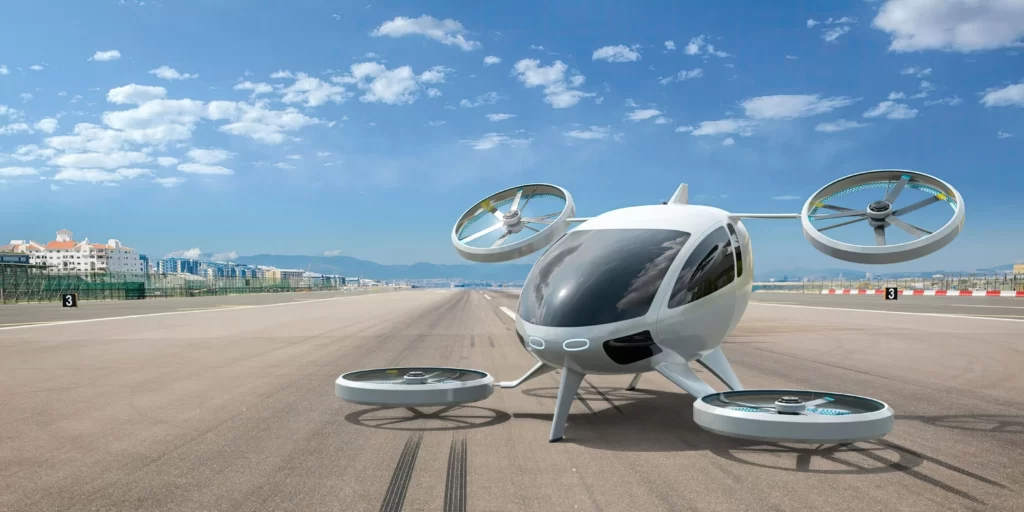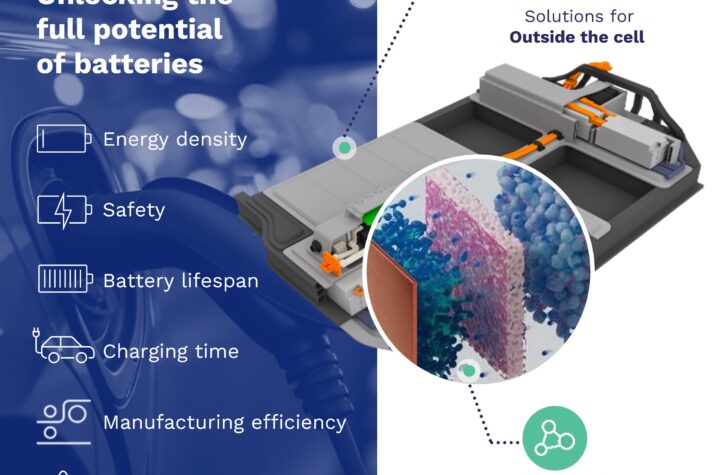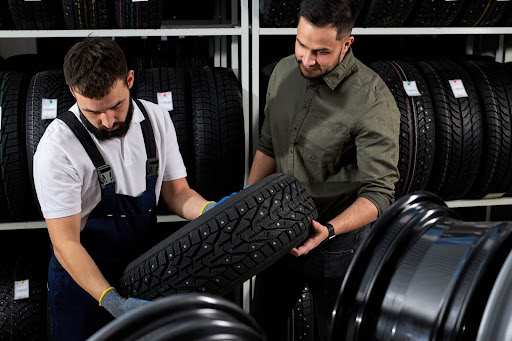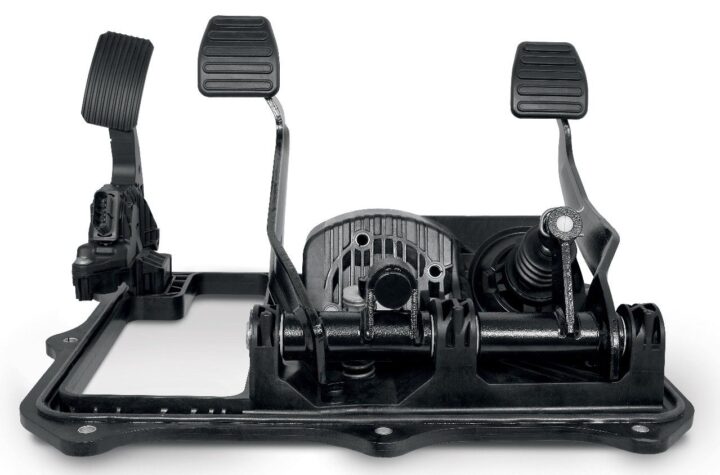
The distance between science fiction and reality narrowed a bit at the 2023 North American International Detroit Auto Show, where Alef Aeronautics debuted its Model A prototype. The vehicle, touted as the first “flying car,” is 17 feet long and has an aerodynamic design. Its frame looks similar to a high-end sedan, with a tinted bubble top serving as the two-passenger cabin. The Model A has a carbon fiber mesh that conceals eight propellers which, when activated, allow the vehicle to take off vertically.
Alef didn’t demonstrate the Model A’s flight capabilities in Detroit, but the automaker did describe its abilities and specifications. According to Alef, the Model A is an electric vehicle that can fly for up to 200 miles or drive nearly 110 miles on a single charge.
What’s the Technology Behind Flying Cars?
While the term “flying car” is fun, it doesn’t really describe what these vehicles are. The true nomenclature is “eVTOL,” or electric vertical takeoff and landing. These models can be placed somewhere between an automobile and a helicopter, with much smaller footprints than traditional aircraft but the ability to fit several human passengers.
The first look at an eVTOL came from NASA in 2009, when the agency shared a video rendering of its Puffin aircraft concept. Since then, many startups and established companies have been eyeing the eVTOL space, bringing the flying car closer to reality than ever before.
There have been a few failures along the way, though. Vertical Aerospace’s VX4 suffered a crash in August 2023 when one of the propellers on an unmanned flight failed. Kittyhawk, once considered to be at the forefront of the flying car industry, drew up designs for several flying vehicles before closing its doors in September 2022. By and large, however, companies in the eVTOL space seem optimistic about introducing vehicles within the next decade.
What Are The Big Names For Flying Cars?
Major aviation companies such as Boeing and Airbus have been developing eVTOL models, though none have gotten fully off the ground. Instead, smaller startups like Joby, AeroMobil, and Volocopter have become the leaders in advancing eVTOL technology. Helijet, a helicopter operator in British Columbia, has already placed orders for flying vehicles from Vermont-based Beta Technologies. By some estimates, eVTOLs could start to become commonplace by 2025.
1. Joby Aviation
Joby is the U.S. company that seems closest to putting an eVTOL on the market. The company was founded in 2009 in Santa Cruz, California, and now has additional offices in San Carlos, California, Washington, D.C., and Munich. The company’s air taxi is designed to accommodate up to four passengers and one pilot at a time and can travel at speeds of up to 200 mph. A single battery charge allows the air taxi to travel distances of up to 150 miles.
In June 2023, Joby announced that the Federal Aviation Administration (FAA) had granted the company a special airworthiness certificate for its first prototype. This certificate allows Joby to conduct test flights.
In a 2021 interview with The Washington Post, Joby founder and CEO JoeBen Bevirt said that a flying taxi ride would initially cost the same as an Uber or Lyft ride, which was about $3 per mile. The company’s goal is to eventually push the price point down to $1 per mile or less.
Joby’s Factory
Up until August 2023, Joby had planned to build its eVTOL factory in Marina, California, a small town in Monterey County. The company had been testing its craft there since 2018 but ultimately decided against situating its factory in the town. Instead, Joby looked for a more symbolic location for its factory that would tie into the history of aviation.
After scouting locations in Ohio and North Carolina, Joby settled on a facility in Dayton, Ohio. Orville and Wilbur Wright, the brothers who are considered the pioneers of modern aviation, were born and raised in Dayton. The Wright brothers opened the first airplane factory in the U.S. in Dayton and returned after successfully testing their glider in Kill Devil Hills, North Carolina.
Dayton is also home to the Air Force Research Laboratories, located at the Wright-Patterson Air Force Base. The lab was a major partner with Joby as it developed the company’s first eVTOL.
Located at Dayton International Airport, Joby’s factory is set to open in 2025 and will be the first of its kind in the U.S. The company plans to invest up to $500 million into the facility and hopes to build at least 500 eVTOL air taxis per year.
2. Alef Aeronautics
Alef Aeronautics, the company that developed the Model A revealed at the Detroit Auto Show, got its start in 2015. Unlike the air taxis being developed by Joby, Alef envisions its flying car as a vehicle for personal use.
Founder and CEO Jim Dukhovny, along with three other engineers, first drew their idea for a flying car on a cafe napkin. They began by experimenting with small-scale models of what would become their eVTOL design, eventually testing a full-size prototype in 2019. The FAA granted Alef a special airworthiness certificate in June 2023, allowing the company to fly its Model A eVTOL prototype for testing and research purposes.
Dukhovny asserts that the Model A will be able to take off vertically and turn into a biplane in midair, but acknowledges that the company faces some headwinds in development. In an interview with the BBC, Dukhovny admitted that “some of the components which we need simply do not exist in the world today,” making the Model A prohibitively expensive for most. While the price point for one is currently $300,000, the company hopes to reduce the price to $35,000 per unit over time.
After the Detroit Auto Show, Alef received almost 2,800 orders for the Model A. The company plans to begin production on these vehicles in either 2025 or early 2026.
3. AeroMobil
Founded in 2010, AeroMobil has enlisted designers whose resumes include automakers such as BMW and McLaren as well as aerospace leaders like Airbus and Lockheed Martin. The Slovakia-based company envisions two types of flying cars: a two-seater model and a four-seater model. The two-seater, like Alef’s Model A, would be a high-end luxury vehicle designed for one pilot and one passenger. The four-seater, which fits three passengers and a pilot, would primarily serve as what CEO Patrick Hessel calls an “Uber of the sky.”
Functionally, AeroMobil’s vehicles aren’t much different from most eVTOLs currently being proposed. However, instead of many small propellers, the AeroMobil vehicle has a rear propeller and wings, which makes it closer to a small airplane than a more dronelike eVTOL. The vehicles also have big wheels, allowing them to be driven on regular roads. These models are 20 feet long, though, making them difficult to navigate on city streets.
AeroMobil vehicles will have to be flown into and out of small airports, making implementation far less convenient than with vehicles that can take off vertically. According to testing that began in 2020, AeroMobil vehicles have a takeoff distance of 1,300 feet and can climb 1,200 feet per minute. They’re hybrid models, so they come with a combustion engine in addition to a battery and other electrical components. A two-seater from Aeromobil can drive up to 600 miles or fly up to 460 miles on a single charge.
Deliveries of AeroMobil vehicles were supposed to start in 2023, but it’s unclear if the company will meet that timeline.
What Will Flying Cars Mean For The Future?
Though eVTOL companies are excited about their timelines for manufacturing and winning FAA approval, the rapid rise of this technology leaves critics concerned about their potential impacts. Some experts believe that the state of the eVTOL industry is similar to that of driverless cars, with the technology developing faster than the world can prepare.
If flying cars become the preferred transit method of the future, governments and regulatory agencies will need to consider a new air traffic control system, the rise of autonomous eVTOLs, and how to address noise pollution caused by flying vehicles. The FAA and NASA will likely need to partner with each other or spin off a new agency altogether. Developing flying cars themselves is only one of the many challenges facing today’s eVTOL industry.
Safety Concerns
First and foremost, flying cars will need to be safe. Beyond making sure that the craft can simply stay in the air–which is the biggest concern currently facing most companies–tests must be conducted to ensure that passengers and their belongings can fit without affecting the eVTOL’s ability to function. The FAA has already begun to implement new training rules specifically for eVTOL pilots, but they’ll need to be updated as the technology becomes more common.
Infrastructure Concerns
If flying cars become more commonplace, infrastructure will need to adapt. Chiefly among infrastructure concerns is the construction of a network of “vertiports,” vertical takeoff and landing facilities. Vertiports will need to be plentiful and accessible, meaning that most buildings will require helipads and flat swaths of land will need to be covered with tarmac.
Air travel corridors would also need to be created. These will have to be far enough off the ground to not interfere with buildings, power lines, and trees, but not high enough to stop the eVTOL from operating properly. It’s easy to imagine that private companies will purchase their own air corridors, either for shipping or passenger purposes. Thus, air rights are likely to become more of a hot-button issue as the technology evolves.
Insurance Concerns
How will eVTOLs be insured? As it stands now, flying cars coming to the market are extremely pricey, making them quite expensive to insure. Each state sets its own car insurance regulations, so it should be interesting to see how governments address the question. Auto insurance companies may create new branches specifically to insure eVTOLs. At the moment, it’s difficult to predict how eVTOL insurance and its availability will develop.
Inequality Concerns
Another topic to consider as eVTOLs move closer to reality is the effect that they’ll have on inequality. In an article for the liberal think tank Center for American Progress, Kevin DeGood asserts that flying cars are a threat to democracy, allowing the wealthy to “achieve a dual demand for hyperseclusion and hyperaccess.”
Flying cars, at least in the beginning stages, will only be accessible to those who can pay expensive rates for travel or shell out hundreds of thousands of dollars to buy their own. If the government begins subsidizing projects for only the richest members of society, it could deepen America’s economic stratification. DeGood argues that as eVTOL technology continues to develop, it should instead be used to create better and more efficient public transportation.
How cool would it be to own a flying car in the future? Why not have special Custom Keychains for the cool guy? Of course, you can also customize them for your current car to show off your unique taste.
Our keychains offer you a wealth of personalization options while satisfying functionality. You can personalize your keychain according to your requirements.
The perfect combination of creativity and practicality! Our keychains not only add fun to your daily life but also elevate your quality of life. Quality life starts from the details! Looking forward to your choice.






More Stories
Arkema: from cell phone to EV batteries in 40 years
BRANO and DOMO join forces to replace aluminum with TECHNYL® polyamide
trinamiX – will cars function like Smartwatches in the future?